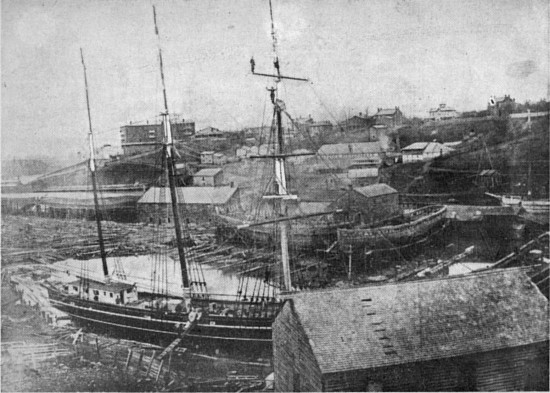Shickluna's Ships Had Long Lives
Toronto Telegram, 24 July 1948
Schooner Days DCCCLVII (857)
By C.H.J. Snider

Louis Shickluna, early shipwright from the royal navy dockyard in Malta, and on the lakes, parent of more wooden sailing vessels than any builder sixty years ago or since, built for a living, but also for the love of it. He was an artist thus. He has been blamed for or credited with, the flat-sided, hard-bilged, full-bowed schooner model with plumb stem, very little overhang aft and small sheer or curve at bow and stern—but this was not his idea. It was what the customer wanted, when he was trying to cram as much cargo as he could through the canal locks. Muirs, Abbeys, Andrews and others on the Welland canal built the same blocky bulk carriers. The characteristics were exaggerated in the full cheeked propellers, which were built high forward anyway to breast the seas, and when cargo-free cocked up like rabbits with the weight of their machinery in the stern.
An honest ship
The Maltese built a solid strong vessel, well-fastened, with plenty of wood and iron in her, for whatever model the customer desired. His ideal, judged by early examples like his "barques" Malta and Pride of America, or the two-masted schooner Fred L. Wells, was a handsome vessel, with a figurehead or cutwater knee by way of decoration; and a good strong sheer. The Malta ran from Chicago to Collingwood in fifty hours. He seemed partial to "barques," that is, barquentines, and his greatest pride was the Valetta, named after his native city. She was burned at Chicago in the great fire of '71 when in her prime.
Shickluna usually built on order, but sometimes on speculation, to keep his yard going. The frequency of his own hard-to-spell name on vessels he built was due to the necessity of having some name registered for the craft so as to place the mortgages covering her builder's costs.
Builders could make money building at $30 a ton or $1 a bushel in the old days. That is, if he got $9,000 or $10,000 for a new schooner, which could carry 300 tons of coal or 10,000 bushels of grain, he felt repaid for his efforts. The "old canalers," three-masters of 700 tons carrying capacity or 22,000 bushels, could be built for $16,000 or $17.000. Labor was $1 a day, oak and pine $10 to $20 a thousand feet BM. They could not be built for $100,000 today.
When the old man built his last schooners, the St. Louis, probably named for Shickluna's patron saint, and the Straubenzee, named for a St. Catharines celebrity, he kept them two years in the pond seasoning, before he would let them go. Grooves were scored in the faces of their deck beams and these were saturated with oil squirted in from scuppers at the crown of the deck which were afterwards carefully plugged. He had great pride in his workmanship.
Hard to kill
The Straubenzee lived thirty-three years, until murdered by a steamer. She had survived the ordeal of the timber trade, for which she was intended, and carrying supplies for the CPR construction work, although this involved several strandings, and she spent one winter in the ice, aground in a northern Lake Huron bay, since called by her name. She also carried heavy blocks of stone from Cleveland for the construction of Toronto's Parliament Building and City Hall. Yet she was in good condition for grain, coal and lumber trades when run down by a passenger steamer at night. The St. Louis died at the ripe age of forty-six. She is said to have been launched at the same time as the Straubenzee but to have been finished three years later.
Good use for the pen
Thrifty, kindly, generous, it is told of Louis Shickluna that when he had learned to sign his name properly he proudly endorsed a promissory note for a St. Catharines man who had befriended him, and assured the borrower that it was well worth learning anything that would enable him to help a needy friend. His yard, which once employed 200 men, vanished in the Welland Canal improvements of 1914 to 1929. He himself had gone to join the company of good master builders.
His sons cared not for shipbuilding but chose professional or business careers. Two of his daughters, several of his grandchildren, two or three nephews and some grand nephews live in St. Catharines and in Port Colborne, Welland and Lincoln counties. He brought a younger brother, Salvo, from Malta, and established him in a spar yard at Port Colborne which later developed to a prosperous ship repair plant. He was reputed to be "the best hearted man to his family and friends, that ever lived in the Niagara peninsula."
